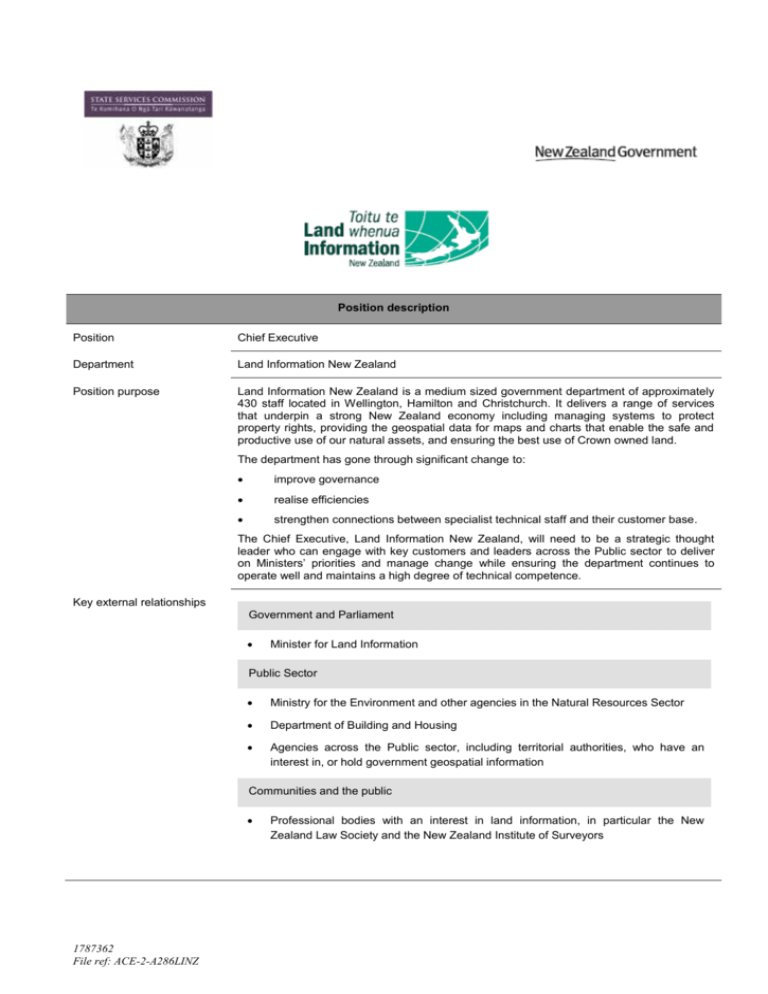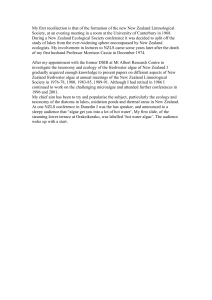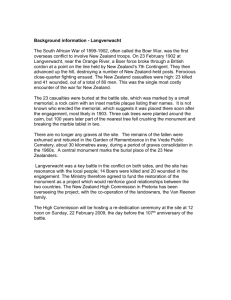
Position description
Position
Chief Executive
Department
Land Information New Zealand
Position purpose
Land Information New Zealand is a medium sized government department of approximately
430 staff located in Wellington, Hamilton and Christchurch. It delivers a range of services
that underpin a strong New Zealand economy including managing systems to protect
property rights, providing the geospatial data for maps and charts that enable the safe and
productive use of our natural assets, and ensuring the best use of Crown owned land.
The department has gone through significant change to:
improve governance
realise efficiencies
strengthen connections between specialist technical staff and their customer base.
The Chief Executive, Land Information New Zealand, will need to be a strategic thought
leader who can engage with key customers and leaders across the Public sector to deliver
on Ministers’ priorities and manage change while ensuring the department continues to
operate well and maintains a high degree of technical competence.
Key external relationships
Government and Parliament
Minister for Land Information
Public Sector
Ministry for the Environment and other agencies in the Natural Resources Sector
Department of Building and Housing
Agencies across the Public sector, including territorial authorities, who have an
interest in, or hold government geospatial information
Communities and the public
1787362
File ref: ACE-2-A286LINZ
Professional bodies with an interest in land information, in particular the New
Zealand Law Society and the New Zealand Institute of Surveyors
Performance profile
Accountabilities
The Chief Executive, Land Information New Zealand, is accountable to the Minister for Land
Information. The Chief Executive must perform the duties as set out in the State Sector Act,
the Public Finance Act and other relevant statutes and legislation, some of which are listed in
the attached departmental profile.
The Chief Executive, Land Information New Zealand, is also accountable for:
providing high quality land information policy advice to Ministers
protecting property rights through the survey and titles system and boundary
definition
regulating and managing the acquisition, disposal or administration of Crown land
and the management of Crown land liabilities
providing a nationally-consistent valuation system for rating purposes
providing support to the Treaty of Waitangi settlements process
providing support to the rebuild of Canterbury
administering the Overseas Investment Act 2005
Critical areas of success
managing and disseminating data for survey, mapping, hydrographic and property
activities.
Over the next three to five years the specific areas of focus for the Chief Executive, Land
Information New Zealand, will be:
engaging with leaders in central and local government to deliver on Land Information
New Zealand’s mandate to lead Public sector agencies in realising the economic
benefits from increased re-use of New Zealand government geospatial information
supporting the rebuild of Canterbury
contributing to the Treaty of Waitangi settlements process
implementing the earning capacity rent policy in the South Island High Country
maintaining customer service and system integrity for the survey and titles system
while examining alternative funding and service delivery models to enable Land
Information New Zealand to modernise and replace the technology in the medium
term to better meet customer needs
engaging with the Department of Building and Housing and territorial authorities to
look at possible synergies with relevant system development work they may be
considering
exploring future policy and management options for Crown land, including the
potential for Land Information New Zealand to play a broader role as a centre of
excellence for advice and management of Crown land.
In addition, the Chief Executive will be required to provide leadership to lift the productivity of
the Public Service and deliver on the results defined by Better Public Services.
2
Person profile
Leadership within the Public
Service
Excellent leadership by Public Service chief executives is essential to high performing
departments and a high performing Public Service. Chief executives are required to work
together in a spirit of service and strive towards the overall goal of a system of world class,
professional State Services, serving the government of the day and meeting the needs of all
New Zealanders.
Position specific
competencies
The descriptors1 below summarise the competencies in which the Chief Executive, Land
Information New Zealand, will need to be skilled.
Factor: Strategic skills
Intellectual horsepower
Is bright and intelligent; Deals with concepts and complexity comfortably; Described as
intellectually sharp, capable and agile.
Managing vision and purpose
Communicates a compelling and inspired vision or sense of core purpose; Talks beyond
today; Talks about possibilities; Is optimistic; Creates milestones and symbols to rally
support behind the vision; Makes the vision sharable by everyone; Can inspire and motivate
entire units or organisations.
Factor: Energy and Drive
Drive for results
Can be counted on to exceed goals successfully; Is constantly and consistently one of the
top performers; Very bottom-line oriented; Steadfastly pushes self and others for results.
Factor: Personal and interpersonal skills
Interpersonal savvy
Relates well to all kinds of people – up, down, and sideways, inside and outside the
organisation; Builds appropriate rapport; Builds constructive and effective relationships;
Uses diplomacy and tact; Can diffuse even high-tension situations comfortably.
Customer focus
Is dedicated to meeting the expectations and requirements of internal and external
customers; Gets first-hand customer information and uses it for improvements in products
and services; Acts with customers in mind; Establishes and maintains effective relationships
with customers and gains their trust and respect.
Peer relationships
Can quickly find common ground and solve problems for the good of all; Can represent
his/her own interests and yet be fair to other groups; Can solve problems with peers with a
minimum of noise; Is seen as a team player and is cooperative; Easily gains trust and
support of peers; Encourages collaboration; Can be candid with peers.
Acting with Honour and Integrity
Integrity and Trust
Is widely trusted; Is seen as a direct, truthful individual; Can present the unvarnished truth in
an appropriate and helpful manner; Keeps confidences; Admits mistakes; Doesn’t
misrepresent him/herself for personal gain.
Security Clearance
Appointment will be subject to a New Zealand Government Secret security clearance.
1
These skill descriptions are based on Lominger International’s LEADERSHIP ARCHITECT Competency Sort Cards, Copyright 1992, 1996,
2001-2003 Lominger Limited, Inc., a subsidiary of Korn/Ferry International ALL RIGHTS RESERVED, and are used with the express permission of
Lominger International.”
3
Departmental Profile as at March 2012
Department
Land Information New Zealand’s three primary functions are to:
regulate and run the system for defining and dealing in property rights
manage core geospatial information to support the efficient operation of
government functions and enable productivity gains, and
administer Crown owned-lands for the benefit of New Zealand.
LINZ also administers New Zealand’s overseas investment regime and has a
number of statutory officers with specific functions under the Acts they administer.
LINZ has approximately 430 staff based in Wellington, Hamilton and Christchurch.
LINZ receives significant funding through revenue gained from charging
customers for its services (third-party revenue). Of LINZ’s total revenue for
2011/12, 56% is estimated to come from third-party revenue and 44% from Crown
funding.
Legislation
Land Information New Zealand (LINZ) is a department of the New Zealand Public
Service in terms of Part II of the State Sector Act 1988. It is subject to the Public
Finance Act 1989.
LINZ administers the following legislation:
Cadastral Survey Act 2002
Crown Grants Act 1908
Crown Pastoral Land Act 1998
Deeds Registration Act 1908
Hunter Gift for the Settlement of Discharged Soldiers Act 1921
Land Act 1948
Land Transfer Act 1952
Land Transfer (Computer Registers and Electronic Lodgement)
Amendment Act 2002
New Zealand Geographic Board Act 2008
Public Works Act 1981
Rating Valuations Act 1998
Reserves and Other Lands Disposal Acts
Valuation Department (Restructuring) Act 1998
Valuers Act 1948
LINZ also has functions under a number of other Acts and has four statutory
officers with functions under the Acts administered by the department including
the:
Commissioner of Crown Lands
Registrar-General of Land
Surveyor-General (also Chairperson of the New Zealand Geographic Board)
Valuer-General (also Chairperson of the Valuers Registration Board)
The Registrar-General of Land and the Surveyor-General have
responsibilities relating to land transactions under more than 50 statutes.
Functions
special
LINZ is responsible for :
the development of land information policy
regulatory frameworks used to define and transact land
providing a secure environment for the buying, selling and subdividing of land
4
property through guaranteed titles for property dealings and an accurate
system of land boundary definition
administering the Crown’s interests in land through the acquisition, disposal or
administration of Crown land, and the management of Crown land liabilities
providing a nationally-consistent valuation system for rating purposes
helping the Government and its agencies address Treaty of Waitangi issues by
providing information on land history and status and contributing to the policy
relating to Treaty settlements
administering the Overseas Investment Act 2005 by:
- making decisions, under delegation, on applications by overseas people
who want to buy significant business assets or certain land in New
Zealand
- advising relevant Ministers (for non-delegated applications, including
fishing quota applications) as to how those applications should be
decided, and
- monitoring compliance with conditions of consent and enforcing
breaches of the overseas investment legislation
ensuring that New Zealand has high-quality databases for its survey,
mapping, hydrographic and property activities.
Government priorities
LINZ aims to contribute to the Government’s economic growth strategy, in
particular:
removing red tape and unnecessary regulation
better, smarter public services
better science, innovation and trade agenda
investing significantly in productive infrastructure.
Outcomes
LINZ aims to:
Impacts
maintain the integrity of the property rights system to encourage trade,
commerce and wellbeing
increase the productive use of geospatial information
enable appropriate economic, environmental and recreational uses of Crownowned and used land.
LINZ aims to make the following impacts by 2014:
maintain the ease of transacting property rights
maintain New Zealanders’ confidence in property rights
increase the productive contribution made by New Zealand government
geospatial information
increase the productive contribution made by LINZ’s datasets
manage Crown land more effectively and sustainably
maintain its deadlines for contributing to Treaty settlements and priority
infrastructure programmes.
5
Organisational Structure
Chief
Executive
Office of the CE
General
Manager
Strategic
Development
and Support
Appropriations
General
Manager Crown
Property and
Investment
General
Manager Policy
and Regulatory
General
Manager
Customer
Services
Chief
Information
Officer
Appropriations in the Vote for the 2011/12 financial year cover the following:
a total of just under $3 million for policy advice about land information
a total of nearly $7 million for standards and quality assurance for the
regulation of:
(i) Crown property management, acquisition and disposal;
(ii) property valuation for rating purposes; and
(iii) the collection, authorisation, management and dissemination of
information associated with the lands rights register, geodetic and
cadastral survey reference systems, and topographic and hydrographic
information systems
a total of nearly $3 million for provision of advice and decisions regarding
overseas investment in New Zealand
a total of just over $69 million for services associated with the collection,
authorisation, management and dissemination of land information
a total of just over $27 million for the delivery of Crown property management,
acquisition and disposal services
a total of just under $4 million for the Oceans Survey 20/20 programme
a total of just under $2 million for the administration of the New Zealand
Geographic Board
a total of $500,000 for remedial work on Crown and private land and property
a total of just over $36 million on other expenses, including
(i) a total of $33 million to pay Transit New Zealand the equivalent of what the
Crown has received from the sales of Transit properties;
(ii) a total of just over $1 million to pay rates on Crown-owned land;
(iii) a total of almost $1 million for the investigation and resolution of land
related liabilities administered by the department; and
(iv) other expenses including the loss on disposal of properties arising from
Crown obligations, management of Crown forest properties, bad and
doubtful debts, depreciation of buildings on Crown land, and the payment
of leasehold liabilities on residual surplus government accommodation
administered by the Department
a total of $1 million for Crown capital expenditure for the purchase of
properties to meet Crown obligations
a total of just over $5 million for departmental capital expenditure on property,
plant, equipment and intangible assets, and
a total of nearly $11 million for capital expenditure on the acquisition of
lessees' interests in pastoral leases (through a multi-year appropriation).
6








